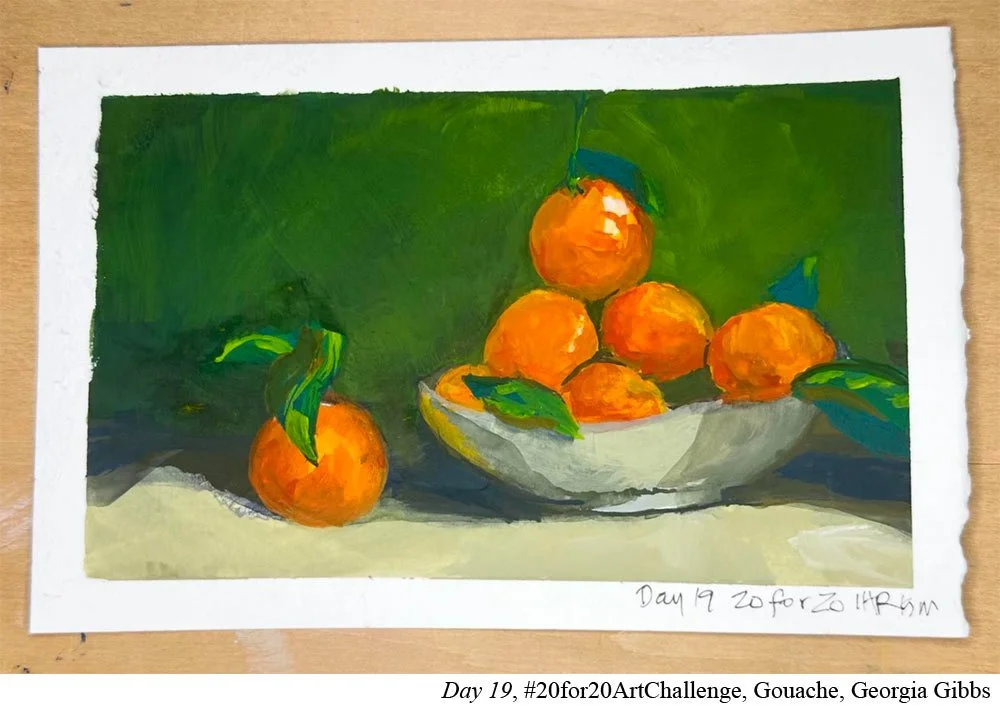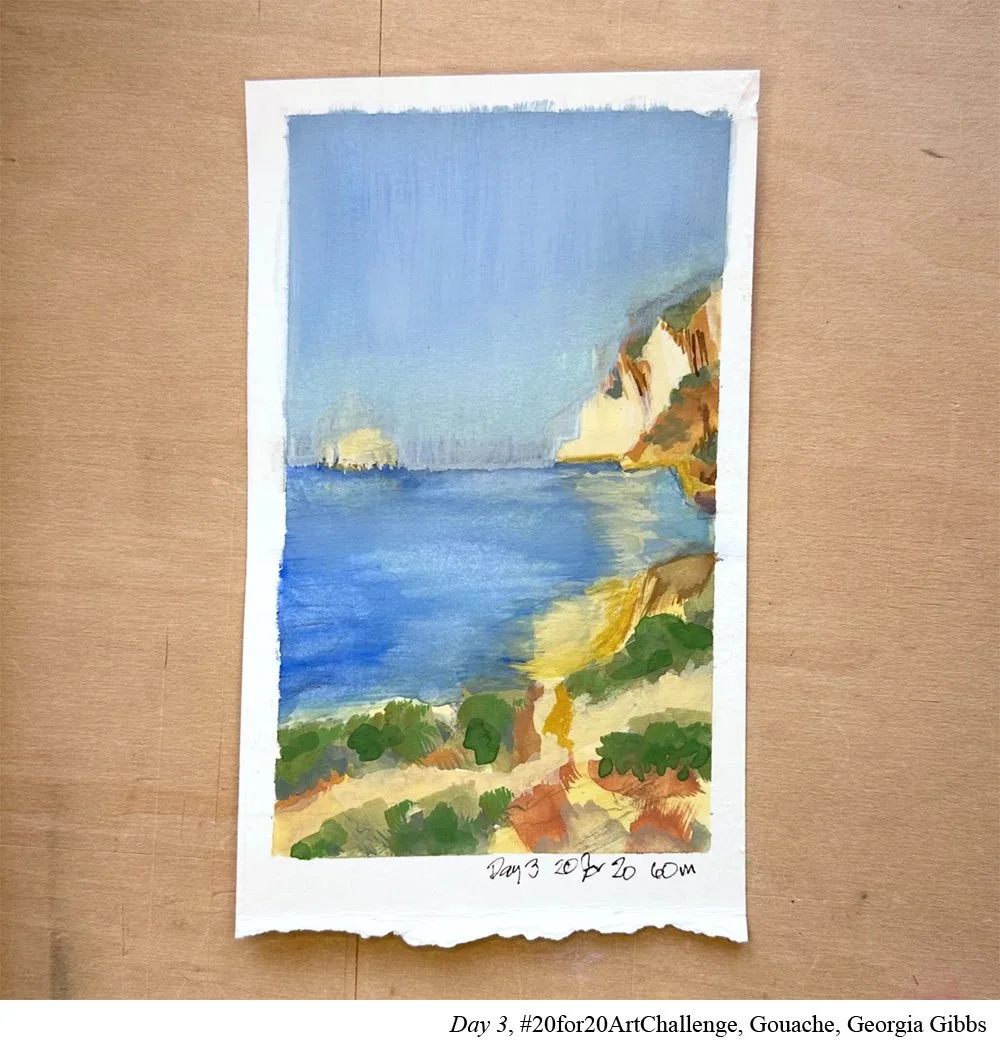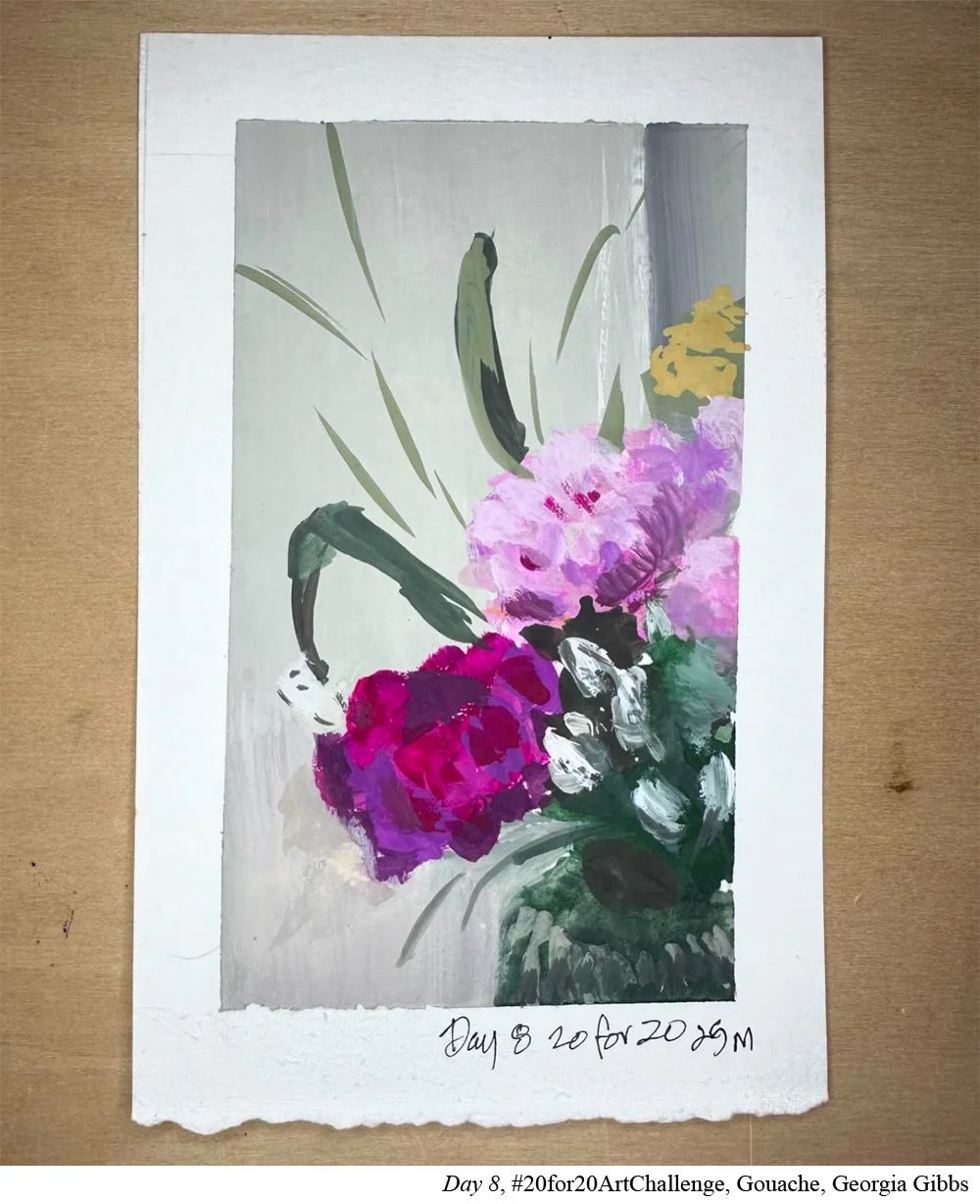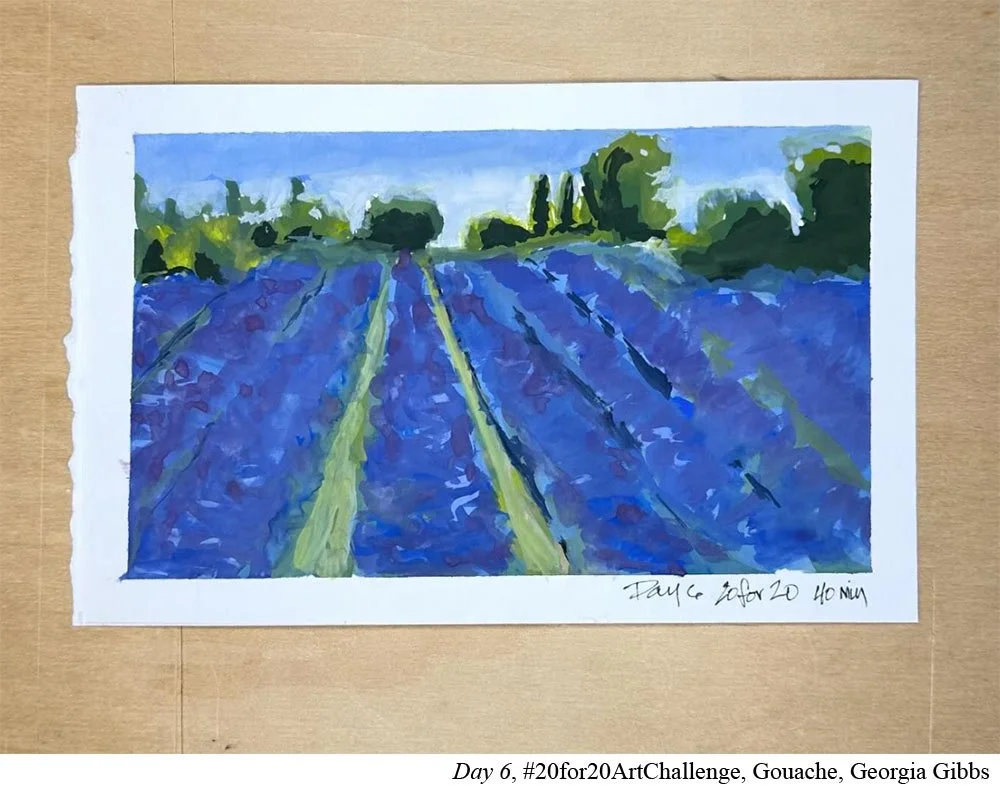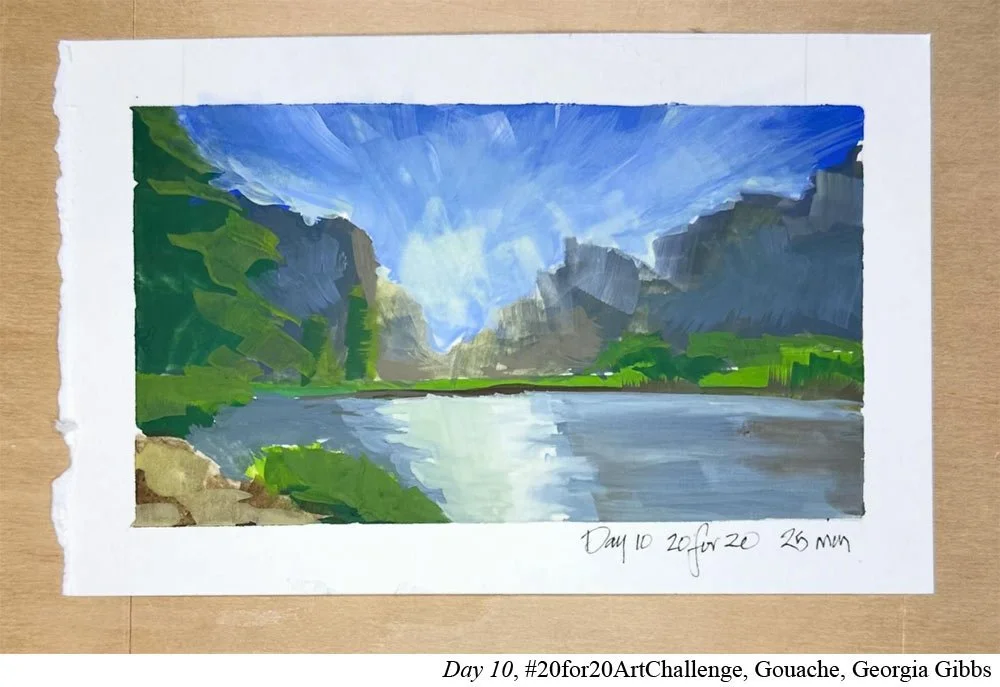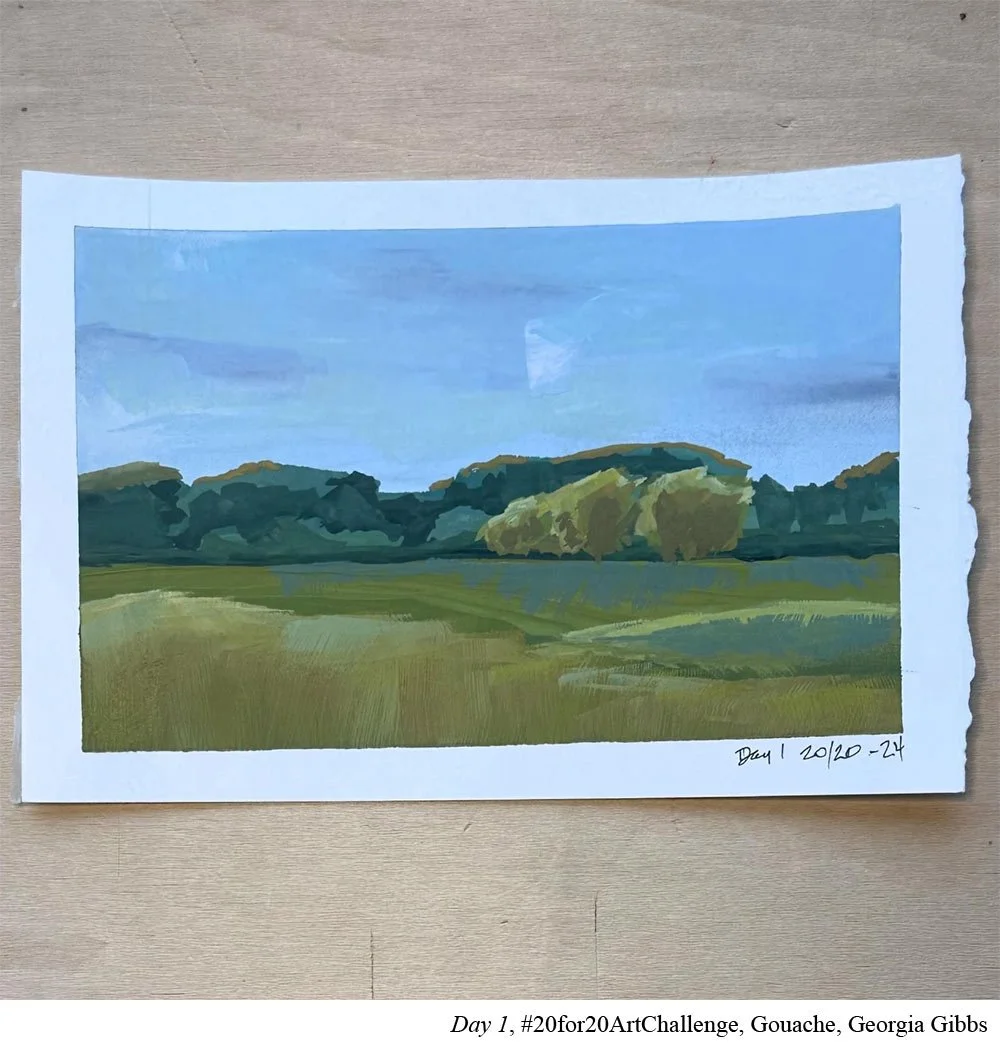#20for20 Artist Spotlight: Georgia Gibbs
Artist Georgia Gibbs has done several #20for20s and she always approaches them with a great strategy. This time her strategy was double. In her last Challenge, she started learning a new medium, gouache. She did so by focusing just on black and white studies. This time she upped her complexity by bringing in color.
You did your daily work in about 20 minutes. Why did you decide to approach the Challenge that way time-wise?
I am not always able to hit 20 minutes but that is the goal. This can be useful in a myriad of ways:
You can do a study in 20 minutes that will help you see if there is a potential finished painting there. It allows you to explore design, value, and pallet options. In this format, you can do several iterations before beginning a painting. This process won’t be canceled out in the final work, but it will let you explore it on a deeper level.
How long did it take you to adjust to that way of working with a time limit? What sort of expectations or systems did you have to change?
Practice is the largest part of the answer: The more one does this the faster you can get with time. Also, working with a larger brush helps: it is impossible to get lost in the weeds and worry over tiny details. Working out your pallet before you begin helps. And - working small is key.
What were the challenges but also what were the benefits of working that way? [Keeping the time to 20ish minutes.]
20 minutes was the biggest challenge. And getting there (or anywhere close) was also the biggest benefit. The objective was not a finished painting but one that could either be a basis to jump off from or enough of a problem that I was able to enjoy a deeper learning experience. And that is really what all of them are: a process to develop my skills and learn more about my tools.
What materials did you use and how did you approach them so that you could keep close to the 20-minute time frame?
I used gouache. I kept a small palette for each one of about 4 - 6 colors plus black or white. I worked on cotton watercolor paper that was cut to the same size.
For most of them, I used reference images supplied by the challenge. One difference was to work in the same format as the photo. There were just a couple of times when images were cropped differently than the original reference.
You’d done a past #20for20 in gouache but using just black and white. Now that you’re working in color, how well did that past Challenge serve you in now working in color? Was that time well spent? And why?
The value study series was very helpful in training my eye to look at the value and not just a color. How it will look when it is closer or further away; when it is turned to the light or in shadow.
I love strong color and have always done work that it is close to high chroma. This can be very effective in certain situations but it does not allow for nuance in your work or in the story you are telling: it is very in your face.
You mentioned that your goals for the Challenge were to work on painting skills and to work with gouache specifically so that it was more painterly. How did you approach the Challenge to help you with those goals?
I am not sure I was successful here. It was an improvement, but a lot of my handling was not natural for gouache. I mixed a thinner paint than I normally would, and sometimes, it felt closer to watercolor but without the translucence. So, this is very much “in progress.”
I did get a more painterly feel though. I was conscious of using looser strokes and for most of it - a larger brush. My first attempts, prior to the Challenge, felt illustrative and stiff.
What benefits did you find working consistently even if not necessarily for a long time? (learning benefits, anxiety benefits, just actually doing it benefits?)
Regular practice does help you grow more in every way. I have done other challenges with you, but this one and the value study were especially helpful and in each instance, I could see such a difference in my work just after 20 days. The added benefit is it is a great confidence builder.
Any days jump out as having aha moments? Could you share what those were and why those days?
Not in that sense - My time and what I was doing was important to me. I was taking in a lot of information during my process–but I had a different spirit about my time. Even setting the timer was an exciting challenge - against myself! I felt playful. I don’t know another way to express it.
So often we walk into a painting with a general goal. How did it change the experience to have a really specific goal for painting? What were the benefits of working that way?
It puts certain fence rails up. Sometimes, that can be a detriment, but other times, it is very useful to give yourself a focus. Looking at a reference photo then becomes an exercise in problem-solving instead of just aesthetics. How can I capture ‘X’, or what brushstroke could help me express that? It makes for a much richer experience
What was the most helpful mindset for you to try and keep during the 20for20?
Sitting down to paint was a joyful and happy part of the day. I was not thinking about any other part of my day and could be completely present. This was a gift. Who would not want to make time for that?
You didn’t do all 20 days but you did keep showing up. It’s so easy as an artist to miss a day and then give up. How did you keep yourself coming back?
I genuinely looked forward to it, and I did not want to let myself down. I like to meet goals that I set so even not being able to do them all was not something I took lightly. I also enjoy the community and want to see what everyone is doing and how they are doing it. It is wonderful to get acquainted with others and a great learning experience just looking at everyone’s work.
What advice would you give to someone doing the Challenge who finds they miss a few days? Do you think it’s still worth it to jump back in? Why?
I do feel it’s important to stay engaged. It is about honoring yourself and keeping your commitment to yourself. This is a very important lesson for each of us. To put our ‘needs’ first. And it is not selfish. It is a win for everyone around us.
What has been the biggest insight to you as an artist (or your practice) because of participating in the Challenge?
I do feel I am getting comfortable with a paintbrush and that I can paint. That is a great place to start. I got here from doing the challenges. The 20 for 20 Challenge is a powerful tool.
You can learn more about artist Georgia Gibbs by checking out her on Instagram at www.instagram.com/georgiagibbs.artist
Learn about the next #20for20ArtChallenge by adding your name to the waitlist below!

